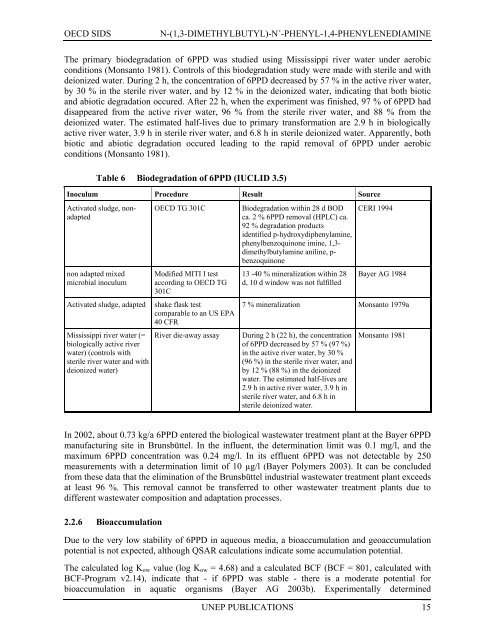N-(1,3-Dimethylbutyl)-N
N-(1,3-Dimethylbutyl)-N
N-(1,3-Dimethylbutyl)-N
You also want an ePaper? Increase the reach of your titles
YUMPU automatically turns print PDFs into web optimized ePapers that Google loves.
OECD SIDS<br />
N-(1,3-DIMETHYLBUTYL)-N´-PHENYL-1,4-PHENYLENEDIAMINE<br />
The primary biodegradation of 6PPD was studied using Mississippi river water under aerobic<br />
conditions (Monsanto 1981). Controls of this biodegradation study were made with sterile and with<br />
deionized water. During 2 h, the concentration of 6PPD decreased by 57 % in the active river water,<br />
by 30 % in the sterile river water, and by 12 % in the deionized water, indicating that both biotic<br />
and abiotic degradation occured. After 22 h, when the experiment was finished, 97 % of 6PPD had<br />
disappeared from the active river water, 96 % from the sterile river water, and 88 % from the<br />
deionized water. The estimated half-lives due to primary transformation are 2.9 h in biologically<br />
active river water, 3.9 h in sterile river water, and 6.8 h in sterile deionized water. Apparently, both<br />
biotic and abiotic degradation occured leading to the rapid removal of 6PPD under aerobic<br />
conditions (Monsanto 1981).<br />
Table 6 Biodegradation of 6PPD (IUCLID 3.5)<br />
Inoculum Procedure Result Source<br />
Activated sludge, nonadapted<br />
non adapted mixed<br />
microbial inoculum<br />
Activated sludge, adapted<br />
Mississippi river water (=<br />
biologically active river<br />
water) (controls with<br />
sterile river water and with<br />
deionized water)<br />
OECD TG 301C<br />
Modified MITI I test<br />
according to OECD TG<br />
301C<br />
shake flask test<br />
comparable to an US EPA<br />
40 CFR<br />
River die-away assay<br />
Biodegradation within 28 d BOD<br />
ca. 2 % 6PPD removal (HPLC) ca.<br />
92 % degradation products<br />
identified p-hydroxydiphenylamine,<br />
phenylbenzoquinone imine, 1,3-<br />
dimethylbutylamine aniline, p-<br />
benzoquinone<br />
13 -40 % mineralization within 28<br />
d, 10 d window was not fulfilled<br />
CERI 1994<br />
Bayer AG 1984<br />
7 % mineralization Monsanto 1979a<br />
During 2 h (22 h), the concentration<br />
of 6PPD decreased by 57 % (97 %)<br />
in the active river water, by 30 %<br />
(96 %) in the sterile river water, and<br />
by 12 % (88 %) in the deionized<br />
water. The estimated half-lives are<br />
2.9 h in active river water, 3.9 h in<br />
sterile river water, and 6.8 h in<br />
sterile deionized water.<br />
Monsanto 1981<br />
In 2002, about 0.73 kg/a 6PPD entered the biological wastewater treatment plant at the Bayer 6PPD<br />
manufacturing site in Brunsbüttel. In the influent, the determination limit was 0.1 mg/l, and the<br />
maximum 6PPD concentration was 0.24 mg/l. In its effluent 6PPD was not detectable by 250<br />
measurements with a determination limit of 10 µg/l (Bayer Polymers 2003). It can be concluded<br />
from these data that the elimination of the Brunsbüttel industrial wastewater treatment plant exceeds<br />
at least 96 %. This removal cannot be transferred to other wastewater treatment plants due to<br />
different wastewater composition and adaptation processes.<br />
2.2.6 Bioaccumulation<br />
Due to the very low stability of 6PPD in aqueous media, a bioaccumulation and geoaccumulation<br />
potential is not expected, although QSAR calculations indicate some accumulation potential.<br />
The calculated log K ow value (log K ow = 4.68) and a calculated BCF (BCF = 801, calculated with<br />
BCF-Program v2.14), indicate that - if 6PPD was stable - there is a moderate potential for<br />
bioaccumulation in aquatic organisms (Bayer AG 2003b). Experimentally determined<br />
UNEP PUBLICATIONS 15
















